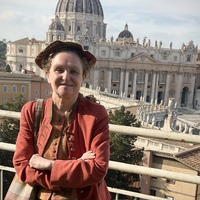
Yvonne Maria Werner
I am professor in history at the Department of History. In my research, I have especially devoted myself to Nordic Catholic cultural history in the 19th and 20th century, and I have participated in respectively led several research projects as for example "The female monastic movement in Scandinavia. A female counter-culture in modern society", "Christian manliness - a paradox of modernity: Men and religion in a North European context 1840-1940"’, and "Anti-Catholicism in a comparative and transnational perspective, 1750-2000". In my doctoral thesis, I studied Swedish-German trade relations around 1900, and I have also analysed the management of suicide in the early modern era. But my research is mainly dealing with the re-establishment of the Catholic Church and Nordic Catholicism Scandinavia in the 19th and 20th century with focus on culture, identity, gender, mission and conversion. On the basis of mission reports from Catholic priests and members of religious orders and congregations, conversion stories and instructions from the Roman ecclesiastical authorities, I have studied the Catholic mission and conversion, identity constructions and cultural encounters between the Catholic and the Protestant. Until the theological reorientation of the Catholic Church in the 1960s, the Catholic activities aimed at winning converts and to create a Catholic ‘milieu’ with churches, associations, schools, hospitals, periodicals etc. The majority of the Catholic priests and women religious at work in Scandinavia came from Catholic Europe, whereas the Catholic parishes were predominantly made up by Scandinavian converts. In several of my works, I have examined the role played by Catholic sisters in these missionary activities and illustrated that female consecrated life can be seen as an alternative strategy of emancipation. Further, I have studied Catholicism and European integration, and Catholic masculinity, taking my starting point in the debates on feminisation and confessionalisation of Christianity, anti-Catholicism in Scandinavia, Swedish church policy in the late 18th century, and materiality and identity in the Scandinavian Catholic local churches from the 1840s onwards.
Address: LUX, Historiska institutionen
Lunds universitet
Box 192, 221 00 Lund
Homepage: http://www.hist.lu.se/person/YvonneMariaWerner
Address: LUX, Historiska institutionen
Lunds universitet
Box 192, 221 00 Lund
Homepage: http://www.hist.lu.se/person/YvonneMariaWerner
less
Related Authors
Patrik Andersson
Uppsala University
C.F. Andersson
Karlstad University
Thomas Arentzen
Uppsala University
Fredrik Santell
Uppsala University
Lovisa Mienna Sjöberg
VID Specialized University
Johanna Andersson
Chalmers University of Technology
Ann-Sofie Lönngren
Södertörn University







Uploads
Books by Yvonne Maria Werner
Vad var som förde människor i de skandinaviska länderna till den katolska kyrkan? Hur motiverades dessa konversioner? Kan man se förändringar över tid? Detta är några av de frågor som tas upp i denna bok som med fokus på de skandinaviska länderna belyser fenomenet katolsk konversion i ett historiskt perspektiv från mitten av 1500-talet och fram till vår tid.
To differentiate such an over-simplified narrative the aim of my article is to present some reflections, based on the development within historical research since the 1980s, on Christian concepts of manliness and the question of the (re-)masculinization of religion in (Western) European discourses from the mid-19th to the first part of the 20th century
Dies bildet der Ausgangspunkt dieser Studie über Männlichkeit und Liturgie 1860-1940. Ziel ist es den diskursiven Stellenwert der Liturgie in der katholischen Mission in Skandinavien und ihre Beziehung zur Weiblichkeit und Männlichkeit zu analysieren. Es geht hier um die Liturgie als ein räumlich situiertes Instrument symbolischer Kommunikation aber auch um die kulturellen Beziehungen zwischen katholisch und protestantisch in einem vom Protestantismus geprägten geographischen Raum. Das Material besteht aus Berichten in Skandinavien tätigen katholischen Priester und Ordensleute, Konversionserzählungen skandinavischer Konvertiten sowie der skandinavischen Medienberichterstattung über katholische Aktivitäten und liturgische Fragen. Darüber hinaus werde ich mit Beispielen aus der protestantischen hochkirchlichen Bewegung die Beziehungen zwischen liturgischer Rekatholizierung und der Frage des Frauenpriestertums beleuchten. Mit dieser in der Zwischenkriegszeit aktualisierten Frage nahm die Debatte zum Thema Geschlecht und Gottesdienst eine neue Wende.
This is the starting point for the research presented in Christian Masculinity. Here we meet Catholic and Protestant men struggling with and for their Christian faith as priests, missionaries, and laymen, as well as ideas and reflections on Christian masculinity in media, fiction, and correspondence of various kinds. Some men engaged in social and missionary work, or strove to harness the masculine combative spirit to Christian ends, while others were eager to show the male character of Christian virtues. This book not only illustrates the importance of religion for the understanding of gender construction, but also the need to take into consideration confessional and institutional aspects of religious identity.
Det är dessa frågor som står i fokus i Nordisk katolicism, som utifrån konversionsberättelser, enkäter, missionsrapporter och debatter ger en färgstark och mångfasetterad bild av katolsk mission och konversion i Norden. Samtidigt tydliggörs spänningsförhållandet mellan katolska och nordiska värderingar. In på 1960-talet framställdes katolicismen ofta som ett hot mot nordisk identitet och nordiska värden. Den rollen har numera övertagits av islam. För den som idag väljer att konvertera till den katolska kyrkan framstår detta steg därmed inte lika drastiskt som tidigare. I boken analyseras orsakerna till denna förändring, vilka konsekvenser de fått för den katolska konversionsdiskursen och vilka skillnader och likheter som finns mellan katolska konversioner då och nu.
Vad var som förde människor i de skandinaviska länderna till den katolska kyrkan? Hur motiverades dessa konversioner? Kan man se förändringar över tid? Detta är några av de frågor som tas upp i denna bok som med fokus på de skandinaviska länderna belyser fenomenet katolsk konversion i ett historiskt perspektiv från mitten av 1500-talet och fram till vår tid.
To differentiate such an over-simplified narrative the aim of my article is to present some reflections, based on the development within historical research since the 1980s, on Christian concepts of manliness and the question of the (re-)masculinization of religion in (Western) European discourses from the mid-19th to the first part of the 20th century
Dies bildet der Ausgangspunkt dieser Studie über Männlichkeit und Liturgie 1860-1940. Ziel ist es den diskursiven Stellenwert der Liturgie in der katholischen Mission in Skandinavien und ihre Beziehung zur Weiblichkeit und Männlichkeit zu analysieren. Es geht hier um die Liturgie als ein räumlich situiertes Instrument symbolischer Kommunikation aber auch um die kulturellen Beziehungen zwischen katholisch und protestantisch in einem vom Protestantismus geprägten geographischen Raum. Das Material besteht aus Berichten in Skandinavien tätigen katholischen Priester und Ordensleute, Konversionserzählungen skandinavischer Konvertiten sowie der skandinavischen Medienberichterstattung über katholische Aktivitäten und liturgische Fragen. Darüber hinaus werde ich mit Beispielen aus der protestantischen hochkirchlichen Bewegung die Beziehungen zwischen liturgischer Rekatholizierung und der Frage des Frauenpriestertums beleuchten. Mit dieser in der Zwischenkriegszeit aktualisierten Frage nahm die Debatte zum Thema Geschlecht und Gottesdienst eine neue Wende.
This is the starting point for the research presented in Christian Masculinity. Here we meet Catholic and Protestant men struggling with and for their Christian faith as priests, missionaries, and laymen, as well as ideas and reflections on Christian masculinity in media, fiction, and correspondence of various kinds. Some men engaged in social and missionary work, or strove to harness the masculine combative spirit to Christian ends, while others were eager to show the male character of Christian virtues. This book not only illustrates the importance of religion for the understanding of gender construction, but also the need to take into consideration confessional and institutional aspects of religious identity.
Det är dessa frågor som står i fokus i Nordisk katolicism, som utifrån konversionsberättelser, enkäter, missionsrapporter och debatter ger en färgstark och mångfasetterad bild av katolsk mission och konversion i Norden. Samtidigt tydliggörs spänningsförhållandet mellan katolska och nordiska värderingar. In på 1960-talet framställdes katolicismen ofta som ett hot mot nordisk identitet och nordiska värden. Den rollen har numera övertagits av islam. För den som idag väljer att konvertera till den katolska kyrkan framstår detta steg därmed inte lika drastiskt som tidigare. I boken analyseras orsakerna till denna förändring, vilka konsekvenser de fått för den katolska konversionsdiskursen och vilka skillnader och likheter som finns mellan katolska konversioner då och nu.
To safeguard what was perceived as true Catholicism, these traditionalist groups, with the Fraternity of St Pius X (SSPX) at the forefront, erected parishes and mission centres alongside the ordinary Catholic parish structures. In 1988, the leader of the movement, the retired French Archbishop Marcel Lefebvre, consecrated four of his priests to bishops without papal permission, thus triggering automatic excommunication. Since then, the traditionalist movement has been divided into two branches, as some members disassociated themselves from SSPX and with the approval of the Holy See formed new traditionalist societies, among them the Fraternity of Saint Peter (FSSP). A common characteristic is the adherence to a preconciliar ecclesiastical order, above all the so-called Tridentine liturgy that is regarded a prerequisite for dogmatic orthodoxy.
In 2007, Pope Benedict XVI made the Tridentine liturgy an integral part of Catholic worship as an extraordinary form of the Roman rite. The purpose was to pave the way for a reconciliation with SSPX but also to contribute to a more dignified celebration of the new Mass. This led to a strong expansion of the celebration of the old liturgy. With the decree Traditionis custodes from 2021, Pope Francis abolished this bi-ritual order and introduced strict regulations for the use of the old liturgy. By intervening as a ”guardian of tradition” the pope emphasized the normative function of the Vatican II and the reformed liturgy and at the same time opened up to give the traditionalist minority a new place within the framework of the Catholic ecclesiastical order.
In Sweden, as in other Protestant countries, the gradual dismantling of the legislation on com-pulsory religious adherence saw the politicization of religious issues. In this situation, the im-agery of the old enemy took on new functions. This was very much the case with the notion of the ‘Catholic danger’, which time and again surfaced in the Swedish media and in parlia-mentary debate. In the 1860s and 1870s, Sweden’s harsh religious legislation was liberalized. The Dissenter Act of 1860 legalized conversions to other Christian denominations, but it put in place many obstacles to leaving the Established Church, and many of the legal restrictions were obviously anti-Catholic in intent. Anti-Catholic sentiment was also expressed in con-junction with the legislative proposals and parliamentary debates on the question of religious freedom that preceded the Act concerning Freedom of Religion of 1951. The fact that full re-ligious freedom was introduced so late stemmed largely from fears that the Catholic Church would grow strong under the protection of a more liberal religious legislation. The article ad-dresses anti-Catholic rhetoric in Sweden from the mid nineteenth century to the early 1960s, with a focus on the debates in the media and in parliament. It is shown that there was a shift in the perception of the ‘Catholic danger’. At the beginning of the period, anti-Catholicism was prompted by a desire to shield Protestant religious unity; later the objective became progressively more secular. Even if the Lutheran heritage still played an important role for Swedish cultural identity, common values were no longer motivated by religion, but purely by politics and ideology. Today it is Islam that is portrayed as a threat to the Nordic community of values, and the current anti-Islamic rhetoric is closely allied to that used until the 1960s against Catholicism.